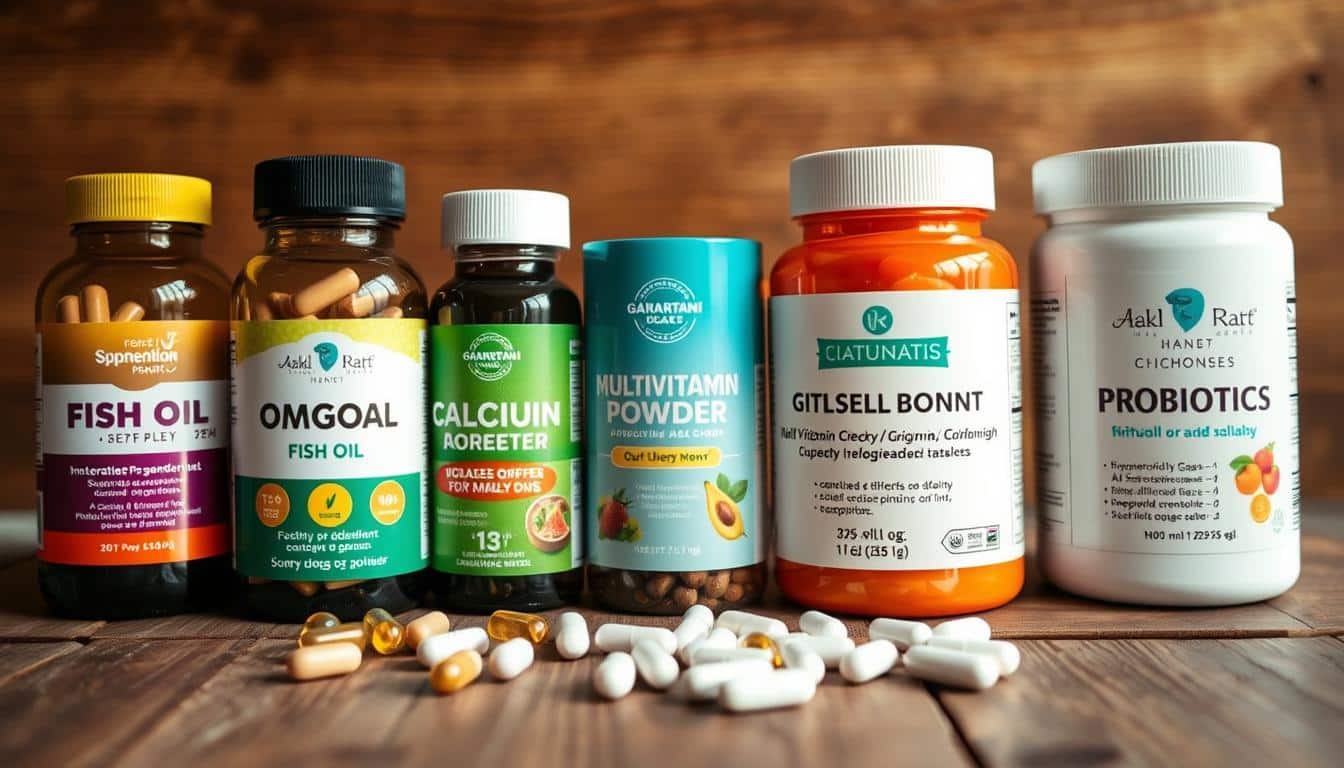Switching to homemade food can help small dogs with allergies. It may reduce problems like itching and ear infections. By making food at home, you avoid processed items that can cause allergic reactions.
Homemade food for small dogs focuses on healthy ingredients. Lean meats and omega-3 sources support their health. Sweet potatoes and pumpkin are good for their stomach.
Always talk to your vet before changing your dog’s diet. A vet can help ensure the food is nutritious and safe. Owners often see benefits after switching to homemade food and care.
Why choose allergy-safe homemade food for small dogs
Making allergy-safe meals at home lets you control every ingredient. This way, it’s easy to avoid triggers and make meals perfect for your small dog’s health. You can ensure the food is balanced and safe.
Control over ingredients to avoid common allergens
With home-cooked meals, you can skip the usual dog allergens like dairy, wheat, eggs, soy, and beef. Choosing simple carbs and single-source proteins helps identify allergies during an elimination diet.
Benefits for skin, coat, and digestive health
Homemade meals with sweet potato, lean turkey, salmon, and omega-3 are great for your dog’s skin and coat. They lead to a shiny coat and less itching. Owners often notice less ear infections and scratching too.
Reducing exposure to processed additives and fillers
Store-bought dog foods often have additives and fillers that can cause reactions. A homemade diet avoids these and helps reduce itching and stomach issues. It’s a safer option for dogs with allergies.
By controlling the ingredients, you support your dog’s skin, digestion, and overall health. Simple changes and consistent homemade meals help manage allergies effectively. This approach allows you to watch your dog’s reaction over time.
Understanding food allergies in small dogs
Food allergies in small dogs are hard to spot. They range from mild itching to severe infections affecting everyday life. Spotting these issues quickly lets owners and vets work together to lessen the dog’s discomfort and make life better.
Common signs to watch for
Watch out for non-stop itching, paw licking, and hair loss spots. These signs often lead to a vet visit.
Recurring ear infections and red, itchy skin are also common. Some dogs may have upset stomachs or start coughing and sneezing from certain foods.
Typical trigger ingredients
- Dairy products and milk-based treats
- Wheat and other gluten-containing grains
- Eggs used in many commercial diets
- Soy found in cheaper kibble
- Beef and common meat proteins
These triggers are behind many dog food reactions. Removing these ingredients often leads to improvement in a few weeks.
What increases risk
Genetics matter. Some breeds and families are more prone to food allergies because of their genes.
Things like household dust mites or fleas can also make allergies worse. The care a dog gets when they’re young is important too.
Research ties antibiotics to higher allergy risks. Early antibiotic use might upset a dog’s gut health, raising the risk of food sensitivities later.
Understanding what causes pet allergies is key. It helps with testing, diet changes, and treatment plans that fit small dogs.
Diagnosing dog food allergies and using elimination diets
If your small dog is always itching, has ear infections, or upset tummy, it’s good to have a plan. Working with your vet, you can figure out if it’s dog food allergies. They’ll check for fleas, environmental allergies, or skin infections too. This way, they guide safe choices and avoid further issues like bacterial or yeast infections.
When to see your veterinarian for testing and guidance
Go see your vet if symptoms don’t get better after a few weeks or usual treatments don’t work. They’ll do a thorough check-up and suggest ways to diagnose the problem. Your vet will also talk about the limitations of certain tests and how an elimination diet can help identify food triggers.
How an elimination diet works and recommended duration
An elimination diet uses a few new ingredients your dog hasn’t tried yet. You should feed only these foods and treats for a certain time and watch for changes. Vets often recommend trying this diet for six to twelve weeks, as it takes time for skin issues to get better.
Monitoring and reintroduction protocol to identify triggers
Write down any scratching, changes in stool, or ear problems every day. If things get better, slowly introduce old foods one by one, following your vet’s advice. If symptoms come back, stop the new food and talk to your vet to pinpoint the problem.
- Stick to prescribed foods and avoid secret treats during testing.
- Photograph skin and ears to document progress for veterinary allergy testing follow-up.
- Ask your vet about balanced homemade formulations or commercial limited-ingredient diets if needed.
Key nutrients for allergy-prone small dogs
Allergy-prone small dogs need special food that helps their skin, digestion, and avoids allergy triggers. Some ingredients are especially good for making home-cooked meals that are balanced. Here are key nutrients and simple foods you can use.
-
Omega-3 support
Omega-3 helps reduce inflammation and makes coats shiny. Adding cooked salmon or a specific amount of fish oil, like the kind from Nordic Naturals, is beneficial. For vegetarian options, flaxseed oil provides ALA, though it’s not as effective for dogs.
-
Lean and novel proteins
Pick proteins that are less likely to cause allergies, like turkey, venison, duck, or whitefish. These are better than beef or dairy. Changing up the protein sources can keep your dog interested without causing allergies.
-
Antioxidants for skin and immunity
To help dog skin, use antioxidants from colorful fruits and veggies. Blueberries, cooked carrots, and spinach are great. They offer vitamins C and E and carotenoids that combat stress and support the immune system.
-
Fiber for digestion
Soluble fiber is great for digestion and making stools firmer. Gentle options like pumpkin, mashed sweet potato, and a little psyllium help good gut bacteria and make bowel movements regular.
-
Gentle carbohydrates
Easy-to-digest carbs like white rice, quinoa, and sweet potato are best. They give energy without upsetting sensitive stomachs. Remember to adjust the portion size for your small dog’s dietary needs.
The right balance is important: focus on the right amount of protein, limited starches, and a variety of vegetables, along with a calcium source. Always work with a vet or nutrition expert to customize the diet for your dog’s specific needs and allergies.
Homemade food for small dogs with allergies
Creating meals at home for small dogs with allergies requires some rules. Start with a good mix of lean meat, easy starches, and soft veggies. Measure everything properly and change proteins often to identify any allergic reactions quickly.
Portioning and macronutrient balance
Usually, feed small dogs about 2% of their body weight each day. This is about 1/2 cup for every 10 pounds they weigh. Since small dogs have quick metabolisms, it’s best to divide their daily food into two or three meals.
The goal is to ensure the food comprises 50% lean meat, 25% starch, and 25% veggies, with a bit of healthy fat and calcium. Always adjust the meal plan based on the dog’s age, how active they are, and advice from the vet.
Safe protein choices
- Ground turkey — lean and well-accepted.
- Salmon — full of omega-3s for a healthy skin and coat.
- Venison — a different type of protein for dogs allergic to beef or chicken.
- Duck — a tasty choice to mix things up.
- Whitefish — mild and digestible, great for sensitive stomachs.
Pick protein sources that have no added stuff. These allergen-free proteins are good at cutting down on unexpected allergic reactions.
Allergy-friendly carbs and vegetables
- Sweet potato — a calming starch that aids digestion.
- Pumpkin — packed with fiber for good stool quality and gut health.
- Brown rice — a mild energy source for dogs with sensitivities.
- Quinoa — an alternative grain that’s often okay for dogs; cook and rinse it first.
- Peas, green beans, carrots, and spinach — nutritious veggies that are simple to digest.
Switch between these safe veggies to give different nutrients and avoid using the same ingredient too much.
Putting a plate together
- First, weigh your dog and figure out their daily food portion using the 2% rule.
- Then, split the food into meals, sticking to the 50/25/25 rule for nutrients.
- Introduce new proteins or veggies one at a time to spot any allergies.
Start with small quantities when introducing quinoa to see if your dog is okay with it. Document every ingredient and the amounts you use. This allows any vet or nutrition specialist to easily review what’s working.
Top homemade recipes and meal ideas for sensitive tummies
Feeding a small dog with a sensitive stomach involves selecting simple, nutritious meals. These meals should avoid ingredients that often cause issues. The ideas and tips below will help you make tasty, easy-on-the-stomach food. We focus on recipes that use digestible ingredients and few allergens. This way, you can switch up proteins and carbs without upsetting your pet.
-
Turkey and sweet potato bowl — Start with cooked ground turkey and mix it with mashed sweet potatoes and peas. Add a little olive oil for healthy fats. This dish is easy on digestion and provides lean protein suited for small dogs.
-
Salmon and quinoa medley — Create a mix of flaked, cooked salmon and quinoa. Add steamed carrots and green beans. A teaspoon of fish oil gives extra omega-3s. This meal aids in maintaining healthy skin and coat.
-
Venison and sweet pea blend — Combine diced, cooked venison with sweet peas and quinoa. Include a bit of coconut oil to enhance flavor. It’s a great choice for dogs allergic to more common proteins.
-
Whitefish and carrot mix — Combine flaked cooked whitefish with mashed steamed carrots and brown rice. Add some fish oil for taste and omega support. This is a gentle option for dogs with sensitive stomachs.
Try changing textures and introducing new proteins like lamb or duck for picky eaters. Adding dishes such as lamb and lentil stew or a turkey and oatmeal bake can offer variety. These hypoallergenic recipes keep your pet’s diet interesting while avoiding common food issues.
Preparing meals in batches and freezing them makes feeding easy. Add bone broth for extra moisture and flavor when needed. By following these steps, each meal stays balanced, safe, and tasty for dogs with dietary restrictions.
How to prepare, store, and serve allergy-safe homemade meals
Making meals safe for allergies needs a consistent method. Begin with washing your hands and cleaning surfaces. Cook meat fully and cool food before serving. Preparing dog food properly keeps harmful germs away and lowers the risk of an allergic reaction from unexpected ingredients.
When making food without allergens, use different cutting boards, utensils, and containers. This action helps prevent mixing allergen-free food with regular pet food or other kitchen items. Put labels on areas used for preparation and store allergy-safe tools in a specific spot.
Portioning for small breeds:
- Start with feeding about 1/2 cup for every 10 pounds of body weight.
- Some prefer using 2% of the dog’s body weight per day, divided into 2 or 3 meals.
- Adjust the food amount based on the dog’s activity, age, and health. Keep an eye on their weight and vitality to adjust their diet correctly.
It’s smart to cook in bulk to save time and keep meals consistent. Make, cool, then store portions in the fridge or freezer. This approach keeps the food nutritious and eases daily cooking stress.
Freezing and thawing tips:
- Use single-meal containers to freeze, reducing waste and easing meal times.
- Write the preparation date and main ingredients on each container to use the oldest ones first.
- Correctly sealed, homemade dog food can be frozen for weeks without losing quality.
Thaw meals in the fridge overnight or quickly in a warm water bath for sealed meals. Warm up meals slowly and mix well to avoid any hot spots that could harm your dog. Stay away from high heat to keep important nutrients like omega-3 oils safe.
Keep freshly cooked meals and bone broth in the fridge for a short time only. Freezing homemade dog food for later use means good portion control and clear labels simplify feeding. Always check thawed food for signs of spoilage and throw out any that smell bad.
To care for dogs with sensitivities, follow these steps closely. Careful meal prep, avoiding cross-contamination, proper portions for small dogs, effective freezing, and cautious heating are key. These methods ensure safe, nutritious outcomes for dogs with allergies.
Transitioning your small dog to a homemade allergy diet
Start slowly to allow your pet to adjust. Taking it step by step lowers stress and supports gut health. It also lets you see how your pet reacts to new foods.
Gradual swap plan to prevent digestive upset
Begin by mixing a little homemade food with their usual meal over 7–10 days. On the first day, mix 10% homemade food with 90% of the usual food.
Gradually increase the homemade food amount every two days until it’s all homemade. This gradual change helps avoid digestive issues that can occur if switched too quickly.
Tracking symptoms and adjusting recipes based on response
Keep track of stool quality, energy, itching, ear discharge, and licking. Noting changes in these symptoms during and after the switch can show what’s working or not.
- Note date and meal composition.
- Record visible signs like scratching or hair loss.
- Log bowel movements for consistency and frequency.
Improve the diet based on symptom changes. Stick with recipes that work and stay away from food that causes issues. If problems occur, stop the new diet and check the ingredients before moving forward.
When to consult your vet or a veterinary nutritionist
Always talk to your vet before starting a homemade diet to ensure it’s safe. Your vet’s advice is crucial for puppies, older dogs, and those with health issues.
If your dog’s dietary needs are complicated, see a veterinary nutritionist. They help balance the diet properly. This is key to prevent missing nutrients and keeping your dog healthy during the switch.
Supplemental additions and treats that support allergy management
Making small changes to meals and snacks helps ease allergy symptoms. It can also make home-cooked meals more appealing for dogs with sensitivities. When using supplements and treats, be careful, keep track of the effects, and talk to your vet about dosage and safety.

Bone broth as a meal enhancer
Start by roasting bones, then gently simmer them for 8–24 hours. After that, strain to get the liquid. Add a few tablespoons to their meals to add hydration and flavor. Bone broth is great for soothing the gut and tempting picky eaters or sick dogs.
Oils and omega supplements
- Fish oil gives dogs EPA and DHA, reducing inflammation and supporting healthy skin and coat. Pick a trusted brand and follow your vet’s dosing advice.
- A flaxseed supplement provides omega-3s from plants and helps with digestion. Measure and mix it into dog food.
- Coconut oil can improve a dog’s coat or soothe dry areas in moderation. Before feeding or applying it, check with your vet.
Hypoallergenic snack ideas
Making treats at home lets you control the ingredients. This avoids common allergens like dairy, wheat, eggs, soy, and beef. Simple treats can include baked turkey or pork meatballs with oats and ground flaxseed. Or try snacks made from pumpkin, sweet potato, or green beans.
When to choose commercial hypoallergenic dog treats
- Look for treats that are limited-ingredient or single-protein for convenience.
- Always read labels to steer clear of hidden allergens.
- Limit treats during food elimination tests to avoid hiding food reactions.
Keep track of any new supplement or snack for 2 to 4 weeks. Watch for changes in itching, stool quality, and energy levels. Stop using a product if your dog reacts badly and get advice from your vet.
Conclusion
Making hypoallergenic dog food at home is a good choice for small dogs with food allergies. You can use healthy ingredients like sweet potatoes, lean proteins, omega-3s, antioxidants, and fiber. This approach helps avoid common allergy triggers and makes your dog’s skin, coat, and stomach better.
To find out if your dog has food allergies, you need help from a vet. You’ll start with an elimination diet, then slowly bring back foods to see what causes problems. It’s important to watch how your dog responds and get advice from experts. Once you know what to avoid, a special homemade diet can really help your dog feel better.
Many dog owners see big improvements when they stop giving their dogs store-bought food and start making it themselves. But, it’s important to make sure homemade meals are balanced. Keep an eye on how your dog is doing, and work with your vet or a nutrition expert. By doing this, you can make sure your dog eats safe, healthy food and has a happier life.
FAQ
What are the common signs that my small dog may have a food allergy?
How can switching to homemade food help itchy or allergy-prone small dogs?
Which ingredients support skin health and reduce inflammation?
What protein sources are least likely to trigger food allergies in small dogs?
How should I portion homemade food for a small dog?
How do elimination diets work and how long do they take?
Can I prepare homemade meals that are nutritionally balanced for long-term use?
Which carbohydrates and vegetables are best for sensitive tummies?
Are there specific homemade recipes that help with itchy skin?
How should I introduce homemade food to avoid digestive upset?
What food safety and preparation steps should I follow for homemade dog meals?
Can supplements and broth help dogs with allergies?
How do I monitor my dog’s response after changing to a homemade allergy-safe diet?
When should I involve a veterinary nutritionist?
Are homemade treats safe for dogs with food allergies?
Content created with the help of Artificial Intelligence.



